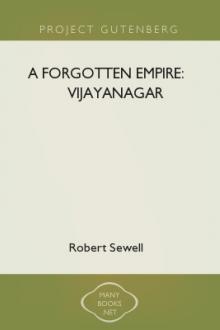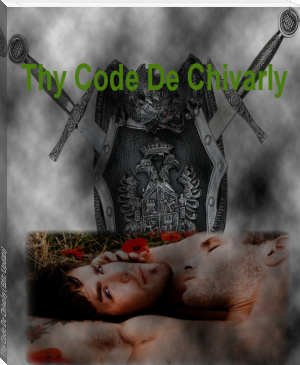A Forgotten Empire: Vijayanagar by Robert Sewell (short story to read TXT) 📕

- Author: Robert Sewell
- Performer: -
Book online «A Forgotten Empire: Vijayanagar by Robert Sewell (short story to read TXT) 📕». Author Robert Sewell
These Christians were the Portuguese under Albuquerque, and the date of their entry into Goa was March 1, A.D. 1510.
At this period there was a complete change in the PERSONNEL of the chief actors on our Indian stage. Ahmad Nizam Shah, who had declared himself independent at Ahmadnagar in A.D. 1490, died in 1508, and was succeeded by his son, a boy of seven years of age named Burhan, with whom the traveller Garcia da Orta182 afterwards became very friendly. Da Orta calls him “my friend.”[183] Yusuf Adil Shah died in A.D. 1510, and his successor on the throne of Bijapur was his son Ismail. Krishna Deva Raya became Raya of Vijayanagar in 1509. The two last-mentioned monarchs were frequently in contact with one another, and in the end, according to our chronicles, the Hindu king was completely victorious. Even Firishtah admits that he dealt Ismail a crushing blow at the great battle of Raichur, a full description of which is given by Nuniz.
But before dealing with the history of the reign of Krishna Deva Raya it is necessary that we should learn how it came about that these Portuguese Christians who seized Goa came to be living in India, and some of them even resident at the Hindu capital.
The Portuguese Arrive in India.
King John of Portugal had acquired some knowledge of India in A.D. 1484, and after causing inquiries to be made as to the possibility of discovering the rich and interesting country in the Far East, had begun to fit out three ships, but he died before they were ready. His successor, Dom Manuel, took up the matter warmly, and sent these ships out under Vasco da Gama and his brother Paulo, with orders to try and double the Cape of Good Hope. The full account of the extraordinary voyage made by them is given in the “Three Voyages of Vasco da Gama,” translated and published in the Hakluyt edition; being a translation of certain portions of Correa’s LENDAS DA INDIA. Da Gama sailed on July 8, A.D. 1497, and arrived close to Calicut on August 26, 1498.[184] The Samuri, or king, of Calicut was at first friendly, but there were misunderstandings on the part of the Portuguese, and they made little or no progress either in trade or in establishing amicable relations with the Hindus. Da Gama returned shortly after to Portugal. Early in 1500 A.D. Cabral took out another and larger fleet, and arrived at Calicut on September 13th. He at once quarrelled with the Samuri, and instead of peaceful commerce we read of attacks and counter-attacks conducted in such sort by the Portuguese as irretrievably to alienate the natives of the country. A few Europeans, however, settled in that tract, and amongst them Duarte Barbosa, the celebrated chronicler of the time.
Da Gama returned to India in 1504, proclaiming the king of Portugal lord of the seas, and wantonly destroying with all hands a large vessel having several hundred people on board near the Indian coast. He reached Calicut on October 29th, and immediately bombarded the city, seizing the inoffensive native fishermen in the port, eight hundred of whom he massacred in cold blood under circumstances of brutal atrocity. In 1503 he again left for Europe, after establishing a factory at Cochin. In consequence of his violence a war ensued between Cochin and Calicut. In 1504 Lopo Soares came out with a fleet of fourteen caravels, and proclaimed a blockade of the port of Cochin, in spite of the fact that the Rajah of that place had always shown great kindness and hospitality to the Portuguese.
The next year, 1505, Almeida was appointed viceroy of the king of Portugal on the Indian coast, and took out with him a large fleet and 1500 soldiers. After some preliminary fighting at Honawar, Almeida began for the first time to perceive that the true interests of the Portuguese lay in peaceful commerce, and not in sanguinary and costly attacks on the natives; and he also learned from an influential native of the existence of the great kingdom of Vijayanagar and the power of its king, Narasimha (or Narasa). At Cannanore the viceroy’s son, Lourenco, in 1506, received further information as to the state of the country from the Italian traveller Varthema, and in consequence of this Almeida asked King Narasa to allow him to erect a fortress at Bhatkal, but no answer was returned.
Varthema has left behind him a valuable account of his experiences185 at this period. He speaks of Goa as being then under the “Savain,” which is this writer’s form of expressing the ruler known to the Portuguese as the “Sabayo,”[186] who was the governor of the place under the Adil Shah of Bijapur. The Sabayo was then at war with Narasimha of Vijayanagar.
He describes Vijayanagar as a great city, “very large and strongly walled. It is situated on the side of a mountain,[187] and is seven miles in circumference. It has a triple circlet of walls.” It was very wealthy and well supplied, situated on a beautiful site, and enjoying an excellent climate. The king “keeps up constantly 40,000 horsemen” and 400 elephants. The elephants each carry six men, and have long swords fastened to their trunks in battle — a description which agrees with that of Nikitin and Paes. “The common people go quite naked, with the exception of a piece of cloth about their middle. The king wears a cap of gold brocade two spans long…. His horse is worth more than some of our cities on account of the ornaments which it wears.”[188] Calicut, he says, was ruined in consequence of its wars with the Portuguese.
Varthema saw forty-eight Portuguese traders massacred at Calicut by the “Moors,” and in consequence of the dangerous state of things existing there he left the city and pursued his journey southwards round the coast. Here we may leave him.
In March 1505 a Portuguese fleet destroyed, with immense loss of life, a large flotilla of small boats belonging to the Rajah of Calicut. In the next year an outrage committed by the Portuguese led to a siege of their factory at Cannanore, but the timely arrival of Tristan da Cunha with a new fleet from home relieved the beleaguered garrison. At the end of 1507 Almeida and Da Cunha joined forces and again attacked Calicut, with some measure of success.
Afonso d’Albuquerque was now in the Persian seas fighting with all the “Moors” he could meet. At the end of 1509 he became “Governor of India,” I.E. of Portuguese India, in succession to Almeida; Diogo Lopes de Sequeira receiving the governorship under the king of Portugal of the seas east of Cape Comorin.
From the accession of Krishna Deva Raya to the throne of Vijayanagar in A.D. 1509 we once more enter a period when the history of the country becomes less confused, and we are able to trace the sequence of events without serious difficulty. This was the period of Vijayanagar’s greatest successes, when its armies were everywhere victorious, and the city was most prosperous.
CHAPTER 10
The Reign of Krishna Deva Raya (A.D. 1509 to 1530)
His character and person — Bankapur — Almeida and Fr. Luis’s mission — Duarte Barbosa — His description of the city — The king’s early wars — Kondapalle — Rajahmundry — Kondavid — Udayagiri — Wars of the Qutb Shah of Golkonda in Telingana.
An inscription in the Pampapati temple at Hampe states that on the occasion of a festival in honour of the coronation of Krishna Deva Raya, the king built a hall of assembly and a GOPURA or tower there, and the date is given as the 14th of the first half of the lunar month Magha in the expired Saka year 1430, the year of the cycle being “Sukla.”[189] It so happens that the cyclic year Sukla does not correspond to Saka 1430 expired, but to Saka 1431 expired; and this unfortunate error leaves us in doubt as to the true date of that important event. If we conceive the mistake as having occurred, not in the NAME of the year, which was perhaps in constant daily use, but in the number of the Saka year, then the date corresponds to 23rd or 24th January A.D. 1510; but if the number of the Saka year was correct and the name wrong, then the day must have been February 4, 1509, the cyclic year being properly “Vibhava.” Even then it is not certain whether this festival took place on the coronation day itself, or on an anniversary of that event; and a considerable interval may have elapsed between the king’s accession and coronation. Probably we shall not be wrong if we consider that the new king succeeded to the throne in A.D. 1509.[190]
Krishna Raya seems to have possessed a very striking personality, to judge from the glowing description given us by Paes, who saw him about the year 1520. The account given by him is all the more interesting and valuable because without it the world would have remained justly in doubt as to whether this king really reigned at all, in the usual acceptation of the word — whether he was not a mere puppet, entirely in the hands of his minister, perhaps even an actual prisoner. For Firishtah never mentions him by name, and the inscriptions which relate his conquests prove nothing beyond the fact that they took place during a reign which, for all we know, might have been a reign only in name, the real power being in the hands of the nobles. But with the description of Paes in our hands there can be no longer a shadow of doubt. Krishna Deva was not only monarch DE JURE, but was in very practical fact an absolute sovereign, of extensive power and strong personal influence. He was the real ruler. He was physically strong in his best days, and kept his strength up to the highest pitch by hard bodily exercise. He rose early, and developed all his muscles by the use of Indian clubs and the use of the sword; he was a fine rider, and was blessed with a noble presence which favourably impressed all who came in contact with him. He commanded his immense armies in person, was able, brave, and statesmanlike, and was withal a man of much gentleness and generosity of character. He was beloved by all and respected by all. Paes writes of him that he was “gallant and perfect in all things.” The only blot on his scutcheon is, that after his great success over the Muhammadan king he grew to be haughty and insolent in his demands. No monarch such as the Adil Shah could brook for a moment such a humiliation as was implied by a peace the condition of which was that he should kiss his triumphant enemy’s foot; and it was beyond all doubt this and similar contemptuous arrogance on the part of successive Hindu rulers that finally led, forty years later, to the downfall of the Hindu empire.
All Southern India was under Krishna Deva’s sway, and several quasi-independent chiefs were his vassals. These were, according to Nuniz, the chief of Seringapatam, and those of Bankapur,[191] Garsopa, Calicut, Bhatkal, and Barkur. The Portuguese treated these lesser chiefs as if they were kings, called them so and sent embassies to them, no doubt much to their satisfaction.
The present head of the Brahmanical establishment at the Hampe temple informed me that Krishna Deva Raya celebrated his accession by erecting the great tower at the





Comments (0)